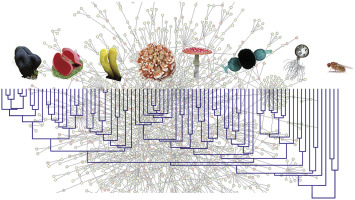Fungal Biology Reviews ( IF 5.7 ) Pub Date : 2018-03-02 , DOI: 10.1016/j.fbr.2018.02.001 Zheng Wang , Aditya Gudibanda , Ugochukwu Ugwuowo , Frances Trail , Jeffrey P. Townsend

|
Fungal model species have contributed to many aspects of modern biology, from biochemistry and cell biology to molecular genetics. Nevertheless, only a few genes associated with morphological development in fungi have been functionally characterized in terms of their genetic or molecular interactions. Evolutionary developmental biology in fungi faces challenges from a lack of fossil records and unresolved species phylogeny, to homoplasy associated with simple morphology. Traditionally, reductive approaches use genetic screens to reveal phenotypes from a large number of mutants; the efficiency of these approaches relies on profound prior knowledge of the genetics and biology of the designated development trait—knowledge which is often not available for even well-studied fungal model species. Reductive approaches become less efficient for the study of developmental traits that are regulated quantitatively by more than one gene via networks. Recent advances in genome-wide analysis performed in representative multicellular fungal models and non-models have greatly improved upon the traditional reductive approaches in fungal evo-devo research by providing clues for focused knockout strategies. In particular, genome-wide gene expression data across developmental processes of interest in multiple species can expedite the advancement of integrative synthetic and systems biology strategies to reveal regulatory networks underlying fungal development.
中文翻译:

利用进化基因组学,转录组学和系统生物学揭示真菌发育潜在的基因网络
从生物化学和细胞生物学到分子遗传学,真菌模型物种已为现代生物学的许多方面做出了贡献。然而,就其遗传或分子相互作用而言,只有少数与真菌形态发育相关的基因在功能上得到了表征。真菌的进化发育生物学面临着以下挑战:缺乏化石记录和尚未解决的物种系统发育,以及与简单形态相关的同质体。传统上,还原法使用遗传筛选来揭示大量突变体的表型。这些方法的效率取决于对指定发育性状的遗传学和生物学的深入了解,即使对于经过深入研究的真菌模型物种,通常也无法获得知识。还原性方法对于研究由网络中多个基因定量调控的发育性状的效率降低。在代表性的多细胞真菌模型和非模型中进行的全基因组分析的最新进展,通过为聚焦基因敲除策略提供线索,大大改进了真菌evo-devo研究中的传统还原方法。特别是,跨多个物种感兴趣的发育过程的全基因组基因表达数据可以加快整合合成和系统生物学策略的进展,以揭示潜在的真菌发育调控网络。在代表性的多细胞真菌模型和非模型中进行的全基因组分析的最新进展,通过为重点基因敲除策略提供线索,大大改进了真菌evo-devo研究中的传统还原方法。特别是,跨多个物种感兴趣的发育过程的全基因组基因表达数据可以加快整合合成和系统生物学策略的进展,以揭示潜在的真菌发育调控网络。通过为集中的敲除策略提供线索,在代表性的多细胞真菌模型和非模型中进行的全基因组分析的最新进展大大改进了真菌evo-devo研究中的传统还原方法。特别是,跨多个物种感兴趣的发育过程的全基因组基因表达数据可以加快综合合成和系统生物学策略的进展,以揭示潜在的真菌发育调控网络。











































 京公网安备 11010802027423号
京公网安备 11010802027423号